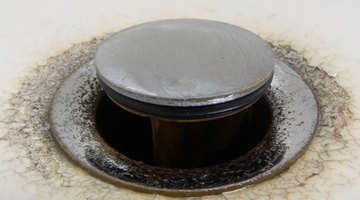How to Reglaze a Porcelain Sink
Old-fashioned, real porcelain sinks are constructed in essentially the same way as old porcelain tubs: The porcelain is baked onto the cast-iron frame and coated with enamel to give it that familiar shine.

When the glaze gets worn and dingy, resurface it in the same way you would a tub, using an etching solution (generally hydrofluoric acid) and spraying on primer and paint made for porcelain resurfacing. It's a complicated project that requires specialized material and equipment, so don't attempt it yourself unless you've had some significant refinishing experience.
Things You Will Need
- Plastic tarping
- Wide painter's tape
- Protective clothing, rubber gloves and goggles
- Respirator
- Porcelain etching solution, with brush
- Paint sprayer
- Porcelain primer
- Porcelain topcoat (paint with polyurethane)
Warning
Open a window in the room or run a fan to disperse the fumes when working with the etching solution and paints.
-
Cover all areas around sink with plastic tarping, using painter's tape to hang it around the walls and floor. Tape off all exposed metal surfaces and fixtures that can't be removed, including any exposed plumbing under the sink. Only the porcelain surface should remain uncovered.
-
Put on goggles, gloves, protective clothing and your respirator.
-
Brush acid-etching solution over the porcelain surface, covering all of it. Let it sit for 15 minutes. Rinse it thoroughly. Dry the sink completely.
-
Load your paint sprayer with porcelain primer. Set the nozzle to a fine mist. Spray the primer over the porcelain in a light, even coat. Let it dry for a half hour, then apply a second coat. Let it dry for half an hour, apply a third coat, then let it dry overnight.
-
Put your protective gear on again. Set up your paint sprayer with porcelain topcoat. Spray it on in the same fashion as you did the primer, using very light, smooth coats, allowing 30 minutes of dry-time between them. Apply four to six coats, to the desired coverage.
-
Let the paint set for three days or more before using the sink.
The Drip Cap
- Old-fashioned, real porcelain sinks are constructed in essentially the same way as old porcelain tubs: The porcelain is baked onto the cast-iron frame and coated with enamel to give it that familiar shine.
- When the glaze gets worn and dingy, resurface it in the same way you would a tub, using an etching solution (generally hydrofluoric acid) and spraying on primer and paint made for porcelain resurfacing.
- Let it dry for a half hour, then apply a second coat.
- Set up your paint sprayer with porcelain topcoat.
References
Photo Credits
- old ugly sink image by Tomasz Stelmach from Fotolia.com
- old ugly sink image by Tomasz Stelmach from Fotolia.com
More Articles



